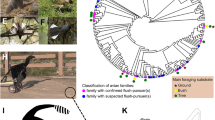Abstract
THE development of the hydranth of Campanularia flexuosa occurs within a capsule of chitin secreted by the hydranth itself1–4. In order to emerge for the first time the hydranth must in some way dispose of the lid of the capsule. Allman4 states that the lid is pushed off in this species. Kramp5 observed that, though the lid is removed in Campanularia, it is wholly or partly retained as an operculum in the Campanulinidae. Hammett6 assumed that ‘the completely developed hydranth repeatedly surging against the cover with great force’ was responsible for weakening the lid prior to emergence. He suggested that the mechanical properties of the chitin at the junction between lid and cup facilitated the clean disposal of the lid. Enzymatic digestion and localized differences in thickness or quality were proposed as possible factors leading to the separation of the lid, Hauschka7 showed that emergence was dependent on the possession of basal attachments to the diaphragm (shelf) and suggested that: “Hydroplasmic pressure adds inflation to the independent exertions of the imprisoned hydranth and may be a contributing factor in emergence”.
This is a preview of subscription content, access via your institution
Access options
Subscribe to this journal
Receive 51 print issues and online access
$199.00 per year
only $3.90 per issue
Buy this article
- Purchase on Springer Link
- Instant access to full article PDF
Prices may be subject to local taxes which are calculated during checkout
Similar content being viewed by others
References
Nutting, C. C., American Hydroids, Smithsonian Inst. Spec. Bull. (1913).
Berrill, N. J., Quart. J. Micro. Sci., 90, 233 (1949).
Agassiz, J. L. R., Contrib. Nat. Hist. U.S.A., 4, (1862).
Allman, G. J., Gymnoblastic Hydroids, 71 (1871).
Kramp, P. L., Medd. Gr nland., 79, 22 (1932).
Hammett, F. S., Growth, 7, 331 (1943).
Hauschka, T., Growth, 8, 321 (1944).
Hale, L. J., J. Emb. Exp. Morph., 12, 517 (1964).
Author information
Authors and Affiliations
Rights and permissions
About this article
Cite this article
KNIGHT, D. Behavioural Aspects of Emergence in the Hydranth of Campanularia flexuosa (Hincks). Nature 206, 1170–1171 (1965). https://doi.org/10.1038/2061170a0
Issue Date:
DOI: https://doi.org/10.1038/2061170a0
This article is cited by
Comments
By submitting a comment you agree to abide by our Terms and Community Guidelines. If you find something abusive or that does not comply with our terms or guidelines please flag it as inappropriate.



